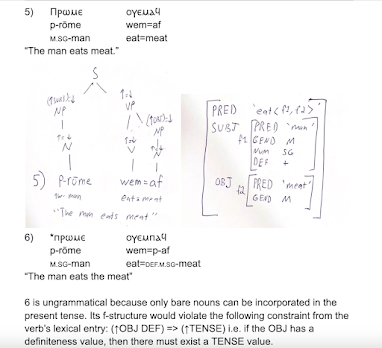Almost through my first year of linguistics grad school قربت نهاية أول سنة لي في برنامج الدكتوراه في اللغويات
I've been neglecting this blog for a while, but I thought I'd share some updates. Grad school has been keeping me pretty busy. In my first semester I took phonetics and syntax. In syntax we learned Lexical Functional Grammar (LFG), an interesting alternative to mainstream generativist syntax. For my final project I used LFG to try to analyze Coptic verb states.
بقالي فترة بهمل البلوج دا بس قولت اشارككم بعض التطوراتت. الحياة في الجامعة مشغلاني كتير وفي التيرم الأول اخذت كورسين هما الأصواتيات (إن صح المصطلح) والنحو وفي كورس النحو تعلمنا ما يسمى (القواعد التوظيفية المعجمية) أي الLFG وهو بديل عجيب للنحو التوليدي الأكثر شعبية وللمشروع النهائي في كورس النحو حاولت تحليل أحوال الأفعال باللغة القبطي من خلال الLFG
This semester I'm in phonology and semantics. Right now we're doing feature geometry and lambda calculus. It's my first time studying semantics since the short unit in my intro linguistics class in undergrad almost 10 years ago, and I'm struck by how much it reminds me of discrete math.
وفي التيرم دا باخد علم الأصوات وعلم الدلالة وحاليا بنتعلم الهندسة الرياضية للسمات وتكامل لامدا وهي أول مرة أدرس علم الدلالة منذ الوحدة الصغيرة في مدخل إلى اللغويات اللي خدته من يجي ١٠ سنين وبستغرب من قد ما بيفكرني بالرياضيات المتقطعة
I've also been taking Sahidic Coptic all year-- which has been interesting because it's taught so much differently than any modern language class I've ever taken (because it's not a modern language). It's taught more from a classics perspective by scholars of early christianity, so I've learned how to say things like "the true nature of the rulers of the universe will be uncovered" but I can't say things like "hello, how are you." I've also learned a lot about gnosticism since most of our readings are from the Nag Hammadi codices. This week forged original texts, making our own ink and writing on real papyri. My short text blended some elements of "hypostasis of the archons" with the middle egyptian story "the shipwrecked sailor."
وكمان طول السنة دي باخد كورس في اللغة القبطية باللهجة الصعيدية وهذا مثير للإهتمام لأنه يتم تدريسها بشكل مختلف جدا عن اللغات المعصرة اللي درستها (وهذا لأنها ليست بلغة معصرة طبعا) بل هي تتدرس من وجهة نظر الكلاسيكيات وعلماء المسيحية في العهد المبكر (إن صح تسمية الزمن فلا أعرف كيف يسمى بالعربي..) لذا تعلمت كيف أقول جمل مثل (سيتم الكشف عن حقيقة طبيعة حكام الكون) لكني لا أعرف كيف أقول جمل مثل (اهلا, كيف حالك؟). كذلك تعلمت الكثير عن الغنوصية عشان كتير من قراياتنا من مكتبة نجع حمادي والأسبوع دا فربكنا نصوص أصلية (أصلية بمعنى اننا ابدعناها ومش انها عتيقة) وعملنا حبر بنفسنا وكتبنا على بردي حقيقي. النص اللي كتبته بيخلط سمات نص غنوصي اسمه قد يُترجم (حقيقة طبيعة الحكام) بنص مصري عتيق (الملاح التائه)
I also recently found a book in Arabic which is a introduction to sign language linguistics. All of its examples are written in Sutton Sign Writing. It unfortunately has many errors in its explanation of some basic concepts like the syllable and the morpheme, but it still provides some interesting linguistic data and other bits of useful information like the dates for the founding of the first deaf schools in Saudi Arabia. It also shows some interesting syntactic patterns.
من شويه عثرت على كتاب بالعربي وهو مدخل الى اللسانيات المؤشرة وكل أمثلته بالSutton Sign Writing لكنه للأسف يحتوي على أخطاء كثيرة في شرحه للبعض المفاهيم الاساسية للسانيات مثل المقطعة والمورفيم (أي وحدة الصرف) ولكنه يوفر بعض البيانات اللغوية التي تثير الإهتمام وبعض المعلومات التاريخية المفيدة مثل تواريخ انشاء أول مدارس للصم في السعودية ويبين بعض الأنماط النحوية التي أثارت اهتمامي
And here's a little preview of my own research on kinship terms across various Arab sign languages. I've been using the Hamburg Notation System to try to capture morphological and phonological correspondences between varieties. Even just looking at a small group of related signs, a lot of interesting patterns have emerged.
وهذا عرض مسبق ضغير لبحثي عن مصطلحات القرابة باللغات الإشارة في العالم العربي اللي بستخدم فيه نظام رموز هامبوغ لتبيين التشارك الصرفي الوفونولوجي بين الأنواع اللغوية وحتى في مجموعة صغيرة من الإشارات المتعلقة ببعض فهناك الكثير مما يثير الاهتمام من حيث الأنماط

.jpeg)
.jpeg)
.jpeg)
.jpeg)


